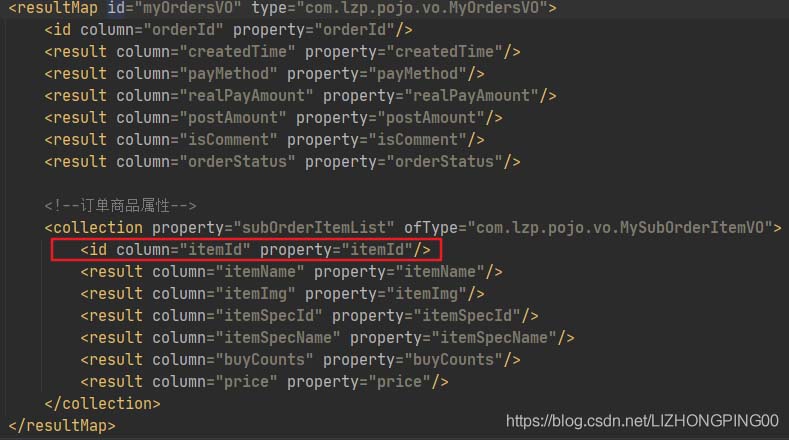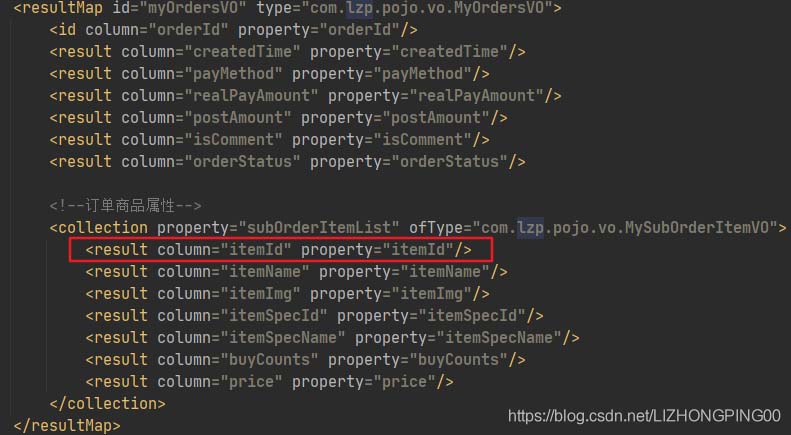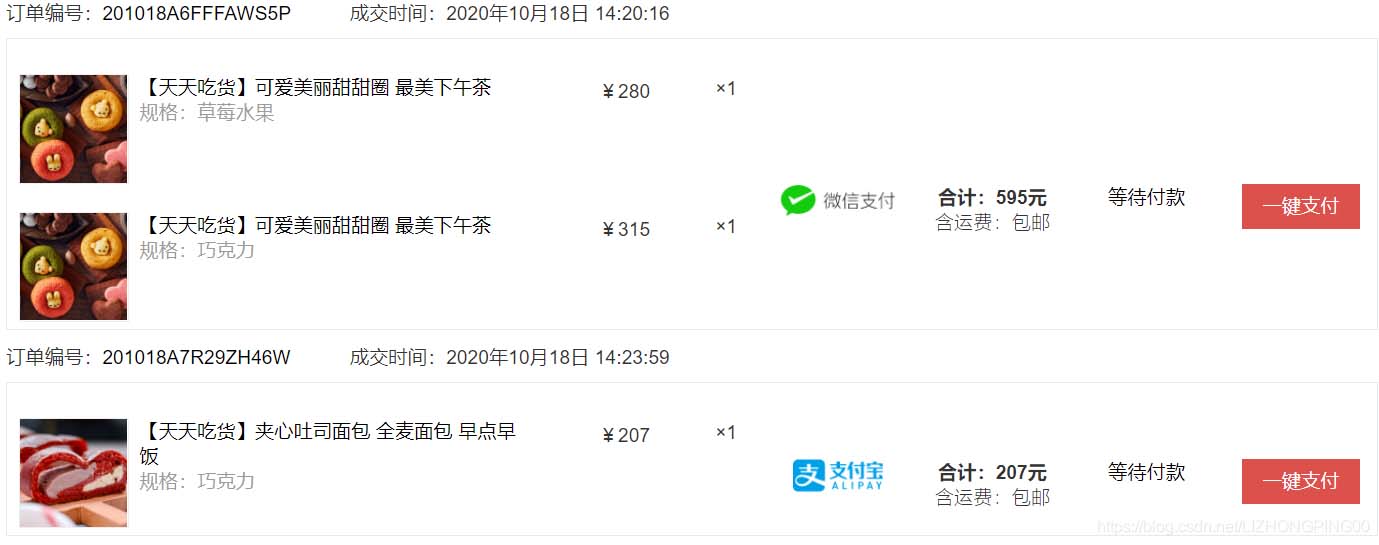MyBatis resultMap id标签使用
BEESTACK 人气:16MyBatis resultMap id标签的错误使用
我们在编写VO对象,如果业务场景稍微复杂一点,就会用到集合属性。例如用户查看个人订单列表,每个订单又包含多种或者多个规格的商品。
本节的问题主要是我对mybatis id标签的错误使用
id是resultMap以及Collection的子标签,标记出作为 ID 的结果可以帮助提高整体性能。特别注意的是,id是当前命名空间中的一个唯一标识,用于标识一个结果映射。
如下图,itemId(商品id)字段值在数据库中不唯一,错误使用会导致只返回该订单某商品的一条记录。因为对于某个商品,麻辣味和五香味只是商品规格,其商品id是相同的。


改用普通result标签后,返回正确结果。


EOF
resultMap标签的使用规则
自定义结果映射规则
<!-- resultMap自定义某个javabean的封装规则
type:自定义规则的java类型
id:唯一id方便引用
-->
<resultMap type="entity.Employee" id="getEmpByIdMap">
<!-- id指定主键列的封装规则
column:指定哪一列
property:指定对应的javabean属性
-->
<id column="id" property="id"/>
<!-- result定义普通列封装规则,若属性名与数据库对应表的列名相同可不写,
mybatis会自动封装,但建议将所有的映射规则都写上
-->
<result column="name" property="name"/>
<result column="sex" property="sex"/>
<result column="email" property="email"/>
</resultMap>
<!-- public Employee getEmpById(Integer id) -->
<select id="getEmpById" resultMap="getEmpByIdMap">
select * from employee where id=#{id}
</select>association联合查询
association可以指定联合的javabean对象property="dept":指定哪个属性是联合对象javaType:指定这个属性的类型
<resultMap type="entity.Employee" id="getEmpAndDeptMap">
<id column="id" property="id"/>
<result column="empName" property="name"/>
<result column="sex" property="sex"/>
<result column="email" property="email"/>
<!-- association可以指定联合的javabean对象
property="dept":指定哪个属性是联合对象
javaType:指定这个属性的类型-->
<association property="dept" javaType="entity.Department">
<id column="did" property="id"/>
<result column="deptName" property="departmentName"/>
</association>
</resultMap>
<!-- public Employee getEmpAndDept(Integer id) -->
<select id="getEmpAndDept" resultMap="getEmpAndDeptMap">
select e.id id,e.name empName,e.email email,e.sex sex,e.d_id d_id,
d.id did,d.name deptName from employee e,dept d
where e.d_id=d.id and e.id=#{id}
</select>使用association进行分布查询
1、先按照员工id查询员工信息将会调用查询员工的sql
2、根据查询员工信息中的d_id值去部门表中查出部门信息
3、部门设置到员工中
<resultMap type="entity.Employee" id="getEmpAndDeptStepMap">
<id column="id" property="id"/>
<result column="name" property="name"/>
<result column="sex" property="sex"/>
<result column="email" property="email"/>
<!-- association定义关联对象的封装规则
select:表明当前属性是调用select指定的方法查出的结果
column:指定将那一列的值作为参数传给这个方法
流程:使用select指定的方法(传入column指定的这列参数的值)查出对象,
并封装给property指定的属性
-->
<!-- discriminator鉴别器
column:指定判定的列名
javaType:列值对应的java类型
-->
<discriminator javaType="string" column="sex">
<!-- resultType不能缺少 -->
<case value="男" resultType="entity.Employee">
<association property="dept" select="dao.DepartmentMapper.getDeptById"
column="d_id">
</association>
</case>
</discriminator>
</resultMap>
<!-- public Employee getEmpByIdStep(Integer id) -->
<select id="getEmpByIdStep" resultMap="getEmpAndDeptStepMap">
select * from employee where id=#{id}
</select>嵌套结果集的方式,使用collection标签定义关联的集合类型的属性封装规则
<resultMap type="entity.Department" id="getDeptByIdPlusMap">
<id column="did" property="id"/>
<result column="deptName" property="departmentName"/>
<!-- collection定义关联集合类型的属性的封装规则
ofType:指定集合里面元素的类型
-->
<collection property="emps" ofType="entity.Employee">
<!-- 定义这个集合中元素的封装规则 -->
<id column="eid" property="id"/>
<result column="empName" property="name"/>
<result column="sex" property="sex"/>
<result column="email" property="email"/>
</collection>
</resultMap>
<!-- public Department getDeptByIdPlus(Integer id) -->
<select id="getDeptByIdPlus" resultMap="getDeptByIdPlusMap">
select d.id did,d.name deptName,e.id eid,
e.name empName,e.sex,e.email
from dept d left join employee e
on d.id=e.d_id
where d.id=#{id}
</select>collection分步查询
<resultMap type="entity.Department" id="getDeptByIdStepMap">
<id column="id" property="id"/>
<result column="name" property="departmentName"/>
<collection property="emps" select="dao.EmployeeMapperPlus.getEmpsByDeptId"
column="{id}">
<!-- 或则 column="{deptId=id}"-->
</collection>
</resultMap>
<!-- public List<Employee> getEmpsByDeptId(Integer deptId -->
<select id="getEmpsByDeptId" resultType="entity.Employee">
select * from employee where d_id=#{deptId}
</select>
<!-- public Department getDeptByIdStep(Integer id) -->
<select id="getDeptByIdStep" resultMap="getDeptByIdStepMap">
select * from dept where id=#{id}
</select>当分布查询需要传递多个多个值时,将多个值封装map传递
colum=“{key1=column1,key2=colum2...}”以上为个人经验,希望能给大家一个参考,也希望大家多多支持。
加载全部内容